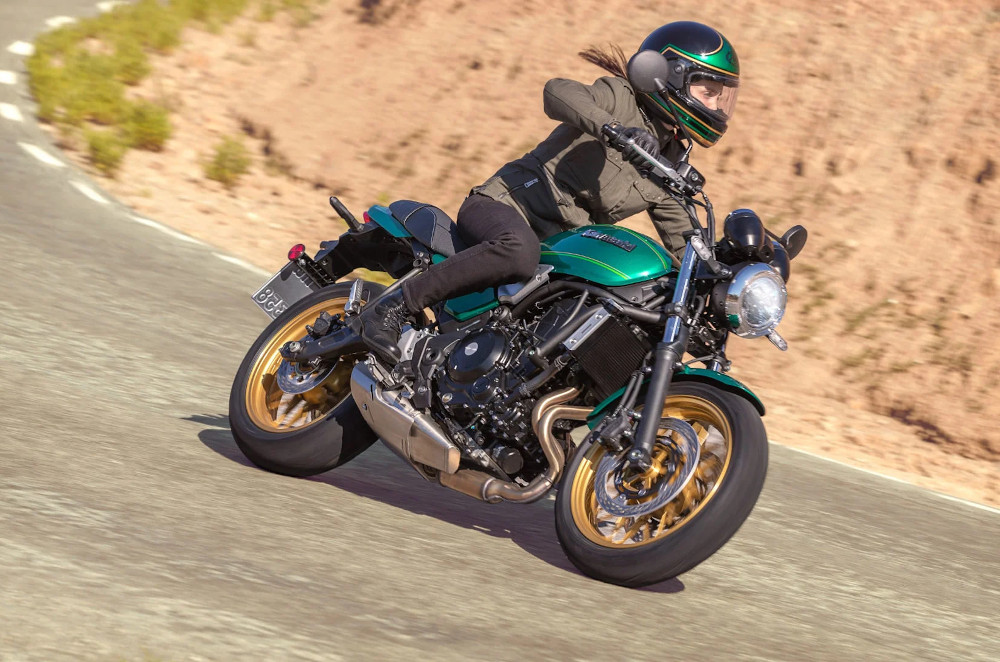Kawasaki Z650RS versus Honda CB650R - Head to head
Two middleweight neo-retro machines with completely different personalities.

These two motorcycles may not seem like a good comparison at first look because one has an inline-four engine and the other a parallel-twin. However, these two motorcycles are more alike than you may imagine in terms of their fundamental design. To begin with, there aren't many other choices if you're looking for a Japanese retro-modern machine outside these two and the Yamaha XSR700, with which we've already contrasted both bikes. Sure, you might have chosen the SV650, but it's obvious that Suzuki's naked bike doesn't perform as well as it could. Its pricing clearly indicates this.
Having said that, it is true that these two bikes are significantly distinct from one another. This is especially true of the ways in which they symbolize a modernized throwback riding experience and how they offer power and performance. The four-cylinder engine of the Honda CB650R clearly adopts a more linear, sportbike-like approach. The Kawasaki Z650RS, meanwhile, has a dynamic personality and all the low-end torque your heart could ever want thanks to its Ninja-derived underpinnings. In order to decide which bike is ideal for you, let's examine these two motorcycles in more detail.
Performance

The CB650R's 649cc inline-four cylinder engine is only the beginning. This engine, which is a carryover from the previous CBR600RR sportbike, is rated to produce 93 horsepower. However, actual dyno tests have shown that this value is more accurately about 80 horsepower to the rear wheel. Most of the power is located at the top, as is typical of inline-four engines; with the CB650R, this occurs at 10,800 rpm. Due to this, the CB650R is surprisingly gentle and docile in urban areas but easily comes to life on highways and wide roads.
Meanwhile, the Kawasaki Z650RS has an engine that has been in use for many years. The reason this engine is used in so many bikes is because it's practical, inexpensive, efficient, and produces a fair level of power at 67 horsepower at 8,000 rpm. This engine is the same one used in a variety of different Kawasakis, including the Z650, Ninja 650, Versys 650, and Vulcan S. Although it might not be the most energetic or powerful motor in its class, it undoubtedly ranks among the most dependable.
Features

The Honda CB650R outperforms the Z650RS in terms of characteristics. It comes standard with Showa BPF separate-function inverted forks, a monochrome LCD instrument panel, and full-LED illumination. Additionally, it has a basic traction control system to prevent inexperienced riders from being passed by the bike's power surge at the top of the rpm range. Naturally, this bike has all of the normal middleweight features, such as ABS, an immobilizer, a side-stand killswitch, and others.
The Kawasaki Z650RS, on the other hand, offers a more relaxed, fundamental riding experience. Despite missing any fancy technology, the Z650RS offers a terrific, exciting ride. However, it includes a digital instrument panel and LED illumination, including a DRL. Naturally, dual-channel ABS is included for smooth stops in all conditions. In spite of its basic construction, this bike can be ideal for you if you don't mind using standard telescopic forks, axial calipers, and no fancy electronics.
Price

If you’re new to motorcycling and want to get started with a stylish and decently powerful neo-retro roadster, then the Z650RS’ P469,000 may be attractive to you. It’s based on a decades-old platform, so it misses out on some modern-day amenities, but is guaranteed reliable and dependable.
The CB650R, priced at P519,000, is a little more expensive but comes with the features to support it. It has more premium features, such as an inverted Showa front fork and finer Nissin radially mounted brake calipers, in addition to producing greater peak power than the Z650RS. However, if you're interested in any of these bikes, it's obvious that cost shouldn't be a concern for you because you'll undoubtedly want to explore the aftermarket for some improvements to further personalize these two dapper machines.
Related Articles
-
3 reasons why the Ducati Monster is the best everyday Ducati / Featured Article
If you’re looking for a Ducati to ride on a daily basis, look no further than the new Ducati Monster.
-
Yamaha YZF-R7 versus Aprilia RS 660 - Head to head / Featured Article
Today, we put the Aprilia RS 660 and the Yamaha YZF-R7 against each other in this spec-sheet brawl.
-
Top 5 naked bike upgrades and accessories / Featured Article
Here’s a quick list of 5 upgrades to your naked sportbike to enhance your riding experience.
-
5 things we love about the Ducati Streetfighter V2 / Featured Article
Here are 5 things we love about the Ducati Streetfighter V2, Ducati’s middleweight hyper naked motorcycle.
-
5 things we love about the Kawasaki Z650RS / Featured Article
Kawasaki’s new Z650RS offers the versatility of a modern naked bike with dapper, retro looks. Here are a few things to love about it.
Latest Features
-
Motorcycle 101: The inner workings of a slipper clutch / Featured Article
Slipper clutches are awesome as they make for more forgiving downshifts and a lighter clutch lever. Let’s take a closer look at them and see how they work.
-
Are Chinese motorcycles worth considering in today's competitive market? / Featured Article
Is made-in-China really that bad? It turns out not really, as today’s Chinese motorcycles are surprisingly well-equipped and capable of competing with mainstream rivals.
-
3 reasons why the Ducati Monster is the best everyday Ducati / Featured Article
If you’re looking for a Ducati to ride on a daily basis, look no further than the new Ducati Monster.











